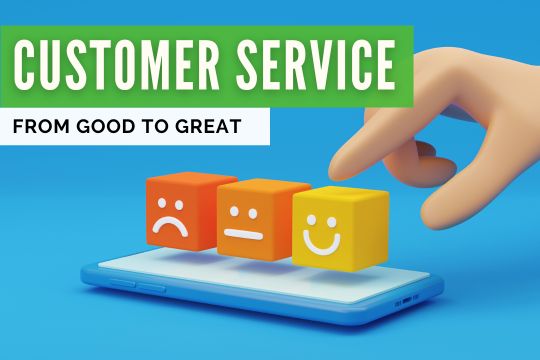
No matter what industry your business serves, customer satisfaction is a core component you can’t afford to overlook. Unfortunately, many business owners find themselves so busy each day that attention to customer service falls by the wayside. In the digital age, word of a bad customer service experience can spread quickly, potentially tarnishing the reputation of your products and services as well as your brand as a whole.

To make matters more complicated, in the ever-competitive digital marketplace, good customer service simply isn’t enough any longer; you need to have great customer service. Each customer service agent or customer support team in your organization needs to have the mindset that if a customer isn’t happy, there’s no rest until the concern is rectified.
If these sound like challenges you’ve been facing at your business, read on to learn how you can improve customer service to take the buyer experience from good to great.
Before you can improve customer service, you first need to define customer service for your organization specifically. What does it mean to deliver great customer service in your industry? What level of customer service is considered the baseline for buyers who frequent your business? What are the expectations customers have before doing business with you, and what are they’re expectations after the first sale? Knowing your starting point is the key to building and growing your customer service strategy.
Once you’ve established the foundation of customer service as it relates to your business, you need to make sure all of the employees in your organization have this level of customer service in mind each and every single day. This should be your starting point, and anything less should be considered unacceptable.
We’ll cover more about incentives below, but your customer service teams and team members all need a shared vision and a reason to care. A paycheck is not enough, or at least, a paycheck will only cause your customer service team to care for so long. At a certain point, you need more than just money to motivate your employees to provide great customer service. In a nutshell, you need to think about how to foster a sense of urgency in all customer service interactions.
Training your team to be customer service leaders is the next step in improving customer service and making the transition from good to great. Training can take on many forms, including group training and one-on-one sessions, but training should be targeted using the standards you’ve set forth in your customer service strategy.
Customer service training ensures that all team members, from your front line employees to your back-end data team members, have the same understanding of what it takes to uphold your company’s dedication to stellar customer service. If you’re going to go the extra mile and deliver customer service that people rave about, everyone needs to be on the same page regarding the direction in which you’re heading.

Once you’ve established what it means to offer great customer service and have fostered common goals with team members, you should then codify this in a training manual that is provided to your teams. Having your customer service policies written down and provided to all employees means no one can claim they didn’t understand or accept the standards to which they are held.
And while creating a manual for customer service training is crucial, you also need to consider ongoing customer service training if you want to continue to improve customer service year over year. Remember that delivering a consistent customer service experience is also vital to transition from lead generation to closing the sales process. Your team likely engages in numerous touchpoints with customers, prospects and leads each day, so don’t waste those opportunities by providing unbalanced customer service or customer service training.
If corrections to employee behavior need to be made, approach these situations with care. You need to call out poor customer service and offer solutions, but doing so in an encouraging manner generally yields positive changes.
Angrily chastising employees who aren’t adhering to your company’s standards can create an adversarial relationship. This only leads to worse performance and the need to restart the training process over again. With time, employees who feel constantly attacked will either stop caring or will quit.
Of course, all of the experience and training in the world doesn’t count for anything if you don’t know what your specific customers expect in terms of service. What you perceive as the customer experience may not be how the customer feels, and if you aren’t “on the ground” all day with your customers, you may not see as many interactions as it takes to gauge your company’s level of customer service. You need to know how customers feel about the experiences they have with your brand, so make it a point to ask questions.
Provide customers with anonymous surveys after completing a transaction, or re-target previous customers who haven’t made a purchase from your brand in a while. This is also how you can derive a net promoter score which is a score that tells brands how likely a customer is to recommend a business to others.
The knowledge you gain from asking customers about their experiences can help your business better shape its customer service strategy, and as a bonus, you show customers you care. This in and of itself is a win in the customer service department because demonstrating you care is a form of customer service.

If you’re doing all of the above, your team members should all be on the same page as far as what’s expected, but sometimes, a little extra incentive to start improving your team’s customer service skills is warranted. Incentives for providing outstanding customer satisfaction can include everything from physical prizes to simple recognition in front of peers. How you choose to incentivize improving upon each employee’s customer service skill will depend on your company and employees, but a small reward can go a long way.
If you take this approach, everyone needs to be eligible for the same rewards and incentives. Leaving out one person or group can foster resentment, potentially leading to worse customer service. If employees don’t feel valued, they aren’t likely to give their all when resolving customer issues. When this happens, each instance of customer contact becomes a waiting game to see if this is going to be the time when an employee simply stops caring altogether.
While in-person customer service is important, more and more customer contact takes place online these days, and more specifically, it takes place across social media. As such, you need to focus just as heavily on your online customer contact experiences as you do those that happen in person. If you don’t have a social media manager or dedicated social media team, make sure you or someone you trust to deliver great customer service monitors your brand’s social media channels throughout each day.
If a customer leaves a negative remark on your business’ social media profiles, respond promptly with care and concern. Encourage the customer to take the discussion private through direct message so that the complaint does not spiral into a public incident.
Make sure you resolve all concerns quickly and to the liking of the customer where possible. You may not be able to fully resolve all concerns considering the nature of complaints on the Internet, but making a complete effort can go a long way in salvaging a rocky customer relationship.
In keeping with the above, give customers a reason to spread the word. Just like incentivizing your employees to provide great customer service, you can use incentives to turn your customers into brand evangelists. To do this, think about how you can offer your customers a starring role as part of your brand.
For example, come up with a contest in which customers send in photos of themselves using your products. At the conclusion of the content, compile a collage of all of the pictures and turn this into a fun presentation to share online or in your store location(s) with others. This gives your customers a reason to tell others about your brand, and it helps to strengthen the customer relationship as your customers become, in a sense, part of the brand experience.
If you want to learn more about how to improve customer service by reaching your customers on the web or mobile devices, contact E-Marketing Associates. We specialize in providing digital solutions that connect businesses with customers across a range of industries, and we’re committed to great customer service too! Contact us today to schedule a 15-minute Discovery Call.
Good service once satisfied customers, but intense competition and instant online reviews have raised expectations; only exceptional experiences gain loyalty and positive word of mouth. Falling short risks rapid reputation damage that spreads across social media.
Define what great service means for your business, write it down, share it widely, and insist on it daily. A common goal backed by clear standards ensures every team member understands and delivers the expected experience.
Targeted group and one-on-one training, supported by a comprehensive manual, equips all staff with consistent skills and goals. Ongoing education nurtures customer service leaders who uphold and advance the company's standards at every touchpoint.
Anonymous surveys and outreach reveal actual customer perceptions, expose service gaps, and provide net promoter scores. Listening and acting on feedback proves you care, guides improvements, and can transform satisfied buyers into enthusiastic brand promoters.
Monitoring social channels, responding quickly, and moving complaints to private messages safeguards your image. Engaging customers online, offering helpful content, and running shareable contests encourage positive stories and turn digital followers into brand evangelists.